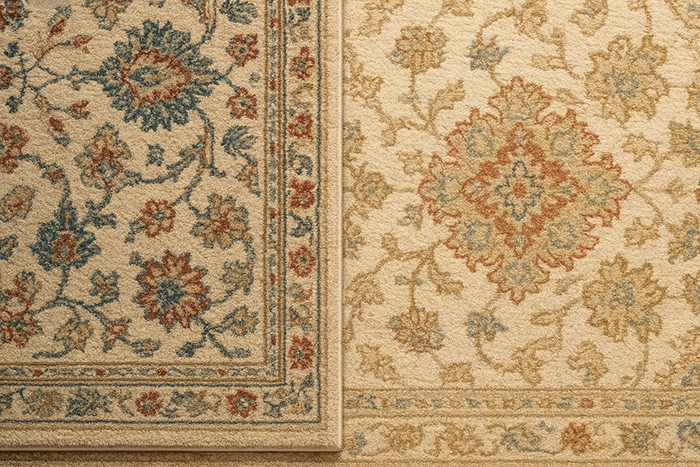Why Material Matters in Carpet Export Decisions
For international buyers, the type of yarn used in machine-made carpets is not a minor detail — it’s a crucial factor that impacts durability, feel, hygiene, and market positioning. While both polyester and acrylic rugs have a strong presence in the export market, they differ significantly in performance, longevity, and customer satisfaction. Understanding these differences can help importers, mosque planners, and bulk buyers make informed purchasing decisions aligned with their local needs and budgets.
Durability and Wear Resistance: Acrylic Leads in High-Traffic Settings
Acrylic yarns, particularly heat-set German acrylic used by Pamchal Carpet Company, offer superior resilience under pressure, making them ideal for mosques, hotels, and public areas with heavy foot traffic. Acrylic retains pile height longer, resists crushing, and maintains clarity in complex designs — even after years of use. Polyester, while affordable, is more prone to flattening, fiber breakage, and fading, especially in warm climates or sun-exposed areas. For export to regions like the Gulf, North Africa, and Central Asia, acrylic is the professional’s choice for long-term projects.
Feel, Comfort, and Texture: Wool-Like vs. Synthetic Touch
One of the biggest differences lies in tactile experience. Acrylic carpets feel more like natural wool — soft, warm, and slightly springy — which adds to the spiritual experience in prayer halls. Polyester rugs, on the other hand, often feel smoother but more plastic-like. This affects not only user comfort but also customer perception of quality, especially in cultural contexts where tactile richness is associated with prestige and sacredness.
Hygiene and Moisture Resistance
Religious and public spaces demand carpets that resist mold, bacteria, and moisture. Acrylic fibers are naturally anti-bacterial, quick-drying, and less likely to retain odors. Polyester tends to absorb sweat and humidity over time, making it less hygienic in environments where shoes are removed. For this reason, mosque carpet buyers in Saudi Arabia, Iraq, and the UAE prefer acrylic compositions for their health standards.
Price vs. Performance: Which Material Offers More Value?
Polyester carpets are cheaper to manufacture, and thus more budget-friendly for short-term or low-traffic use. They are commonly used in home décor or seasonal installations. Acrylic carpets, while more expensive, offer significantly higher ROI due to longer lifespan, reduced maintenance, and stronger aesthetics. For clients looking to outfit mosques, schools, or governmental halls, investing in acrylic ensures fewer replacements and higher satisfaction.
Related: How Density Affects Mosque Carpet Quality
Related: Pamchal’s 700 Reed Acrylic Carpets for Religious Use
Pamchal’s Export-Grade Acrylic Solutions
Pamchal Carpet exclusively produces machine-made rugs with 100% heat-set acrylic yarns, avoiding low-quality polyester mixes entirely. Their carpets undergo:
- UV-resistance testing
- Anti-slip backing integration
- Colorfastness certification
- High-density weaving (700–1500 reeds)
These technical specifications are specifically tailored for international clients demanding durability and beauty — not compromise.
Conclusion:
While both polyester and acrylic carpets have roles in the global market, acrylic clearly outperforms in all key technical areas for religious, public, and export applications. From resilience and hygiene to tactile richness, Pamchal’s acrylic carpet lines deliver long-term value trusted across the Middle East and beyond. Buyers aiming for lasting quality should choose acrylic — and choose Pamchal Carpet Company.

